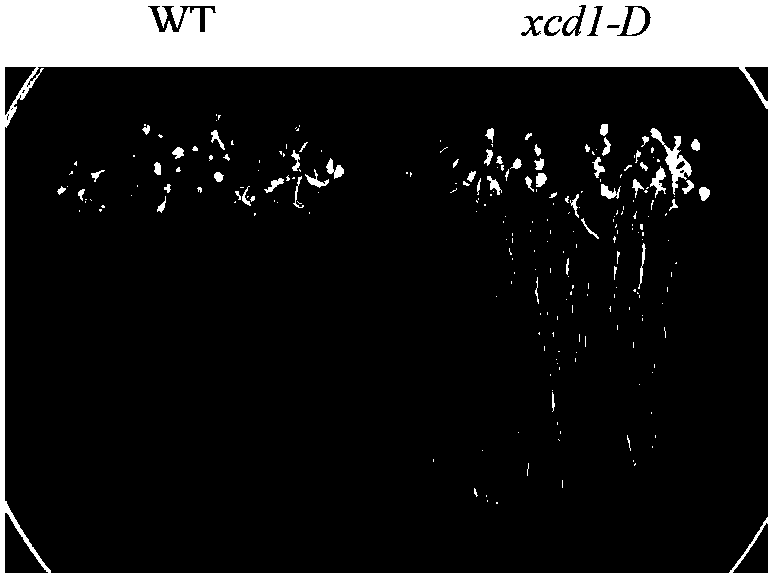Gene improving cadmium tolerance of plant and application thereof
A cadmium, plant-resistant technology, applied in the field of bioengineering, can solve problems such as damage to the normal function of the body, soil, water source damage, etc.
- Summary
- Abstract
- Description
- Claims
- Application Information
AI Technical Summary
Problems solved by technology
Method used
Image
Examples
Embodiment 1
[0033] Embodiment 1, the acquisition of XCD1 and its coding gene
[0034] Using chemical induction to activate the XVE (LexA-VP16-ER) mutant system (provided by the Institute of Genetics and Developmental Biology, Chinese Academy of Sciences), from containing 100 μM CdCl 2 The Arabidopsis seedlings screened in the 1 / 2MS medium were used as materials ( figure 1 ), use the mutant genomic DNA extracted by the classic CTAB method as a template, and perform the following Tail-PCR reaction (Yao-Guang Liu et al., 1995):
[0035] Tail-PCR reaction program (including three rounds of reaction, Table 1):
[0036]
[0037]
[0038] Table 1 Tail-PCR reaction program
[0039]
[0040] Among them, nested primers: LexA2, LexA3, LexA4, LexA5, LexA6, and random primers: AD1, AD2, AD3, AD4 are shown in Table 2.
[0041] Table 2 Primer sequences used in Tail-PCR
[0042]
[0043]
[0044] Perform 1% agarose gel electrophoresis on the third-round product of Tail-PCR. The obtained ...
Embodiment 2
[0045] Embodiment 2, cultivate cadmium-tolerant Arabidopsis thaliana
[0046] 1. Obtaining and phenotypic analysis of cadmium-tolerant mutant xcd1
[0047] The Arabidopsis mutant library of independent transformation lines constructed by chemically inducing and activating the XVE (LexA-VP16-ER) mutant system, under the stress condition of 100 μM CdCl2 and the induction of 10 μM external hormone β-estradiol, at 1 / The WT and mutants were sowed in 2MS medium and cultured horizontally for 1w, and several cadmium-tolerant mutants were screened ( figure 1 ), the larger seedlings were selected for follow-up research, and the gain-of-function cadmium-tolerant mutant xcd1 was obtained through phenotypic identification (Fig. 2A-C).
[0048] 2. Comparison of cadmium accumulation between xcd1 and wild-type plants
[0049] Since the induction and activation of XCD1 will significantly enhance the plant's tolerance to heavy metal Cd, whether the Cd content in the mutant also changes. Ther...
PUM
 Login to View More
Login to View More Abstract
Description
Claims
Application Information
 Login to View More
Login to View More - R&D
- Intellectual Property
- Life Sciences
- Materials
- Tech Scout
- Unparalleled Data Quality
- Higher Quality Content
- 60% Fewer Hallucinations
Browse by: Latest US Patents, China's latest patents, Technical Efficacy Thesaurus, Application Domain, Technology Topic, Popular Technical Reports.
© 2025 PatSnap. All rights reserved.Legal|Privacy policy|Modern Slavery Act Transparency Statement|Sitemap|About US| Contact US: help@patsnap.com



